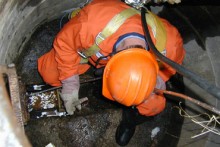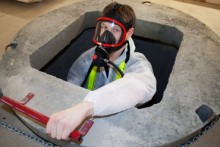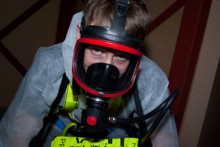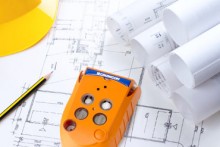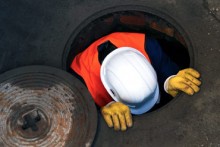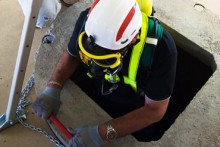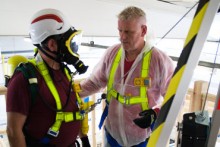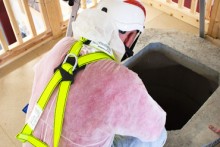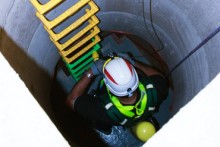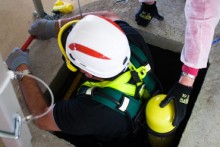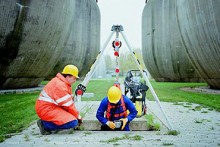Although a confined space sounds like it refers to a small area with limited space to operate, the actual definition is slightly different.
A confined space can be any space of an enclosed nature where there is a risk of death or serious injury from hazardous substances or dangerous conditions. The space does not have to be small, but has to be enclosed in a certain fashion – for example, a small hole can be a confined space, but a larger area such as an underground cellar or something as simple as a room within a property can be defined as a confined space.
As this is the case, it is impossible to construct a comprehensive list of areas that are defined as a confined space. It’s even possible for areas that were not confined originally to become enclosed due to work, construction, fabrication or modification.
It is therefore important to assess each area individually in order to define whether or not the area is confined. You can read more on this subject later on this page.
Confined Spaces Can Be Anywhere
Some obvious examples of confined spaces are easy to spot. The following examples are all enclosures with limited openings:
- Storage tanks
- Silos
- Reaction Vessels
- Enclosed Drains
- Sewers
- Open-topped chambers
- Vats
- Combustion chambers such as those found in furnaces
- Ductwork
- Unventilated or poorly ventilated rooms
Classifying a Confined Space
Before any entry is attempted into a confined space, extensive risk assessments must be undertaken in order to determine the risk level of the area. This is combined together with training and equipment provided to staff in order to ensure that maximum safety is maintained at all times in and around the space.
Generally we break down confined spaces into three distinct risk levels: low, medium and high. Obviously a low risk area is much less dangerous than a high risk area, but it is still extremely dangerous for anyone going inside.
What is a Low Risk Confined Space?
Every confined space should always be individually assessed in order to determine the level of hazard that the space presents to anyone who may be working near to or inside the space. It is the responsibility of an employer to ensure that a confined space is designated with a class rating of low risk, medium risk or high risk in order to identify the specialist training, instruction and equipment required to work safely within these environments.
A low risk confined space is defined as a space with shallow entry with adequate natural or mechanical ventilation where access is simple and unobstructed with no likely risk of flooding. Examples include meter pits, valve chambers, booster pumping stations and PRV chambers.
Although less dangerous than medium risk and high risk spaces, a low risk confined space must also be treated with respect and those working in the space must be given the equipment necessary to work safely within this environment.
Equipment required for entry into these areas can include:
- Personal protective clothing such as overalls, waterproofs, gloves, hats etc
- Portable gas monitor capable of detecting low oxygen levels, explosive and toxic atmospheres
- Explosion protected lighting
- Mechanical ventilation
These spaces pose the lowest risk to those entering them, but can still kill or injure.
What is a Medium Risk Confined Space?
Within a medium-risk confined space, there exists a much larger hazard to those within than a lower risk space does.
Whereas a low risk confined space has easy entry/exit, natural ventilation and the reduced risk of a hazard appearing, a medium-risk confined space has restricted entrances and exists and there exists a realistic expectation of a hazard appearing when working.
These hazards could be anything from sudden oxygen deprivation to the introduction of toxic fumes into the environment. Preparing for these eventualities is essential in medium-risk confined spaces; the employer and top man responsible for the team should have defined the risk the confined space posed and should have provided training/specialist equipment such as breathing apparatus for those entering the space. Qualified rescue personnel should also be on hand should something go wrong within the space.
Equipment required for entry into medium risk confined spaces can include:
- Personal protective clothing such as overalls, waterproofs and gloves
- Portable gas monitor capable of detecting low oxygen, explosive and appropriate toxic atmospheres
- Hard line for lowering tools etc
- Mechanical full man riding winches.
- Appropriate full body harnesses
- Escape breathing apparatus
- Means of contacting emergency services
- Means of communicating with team members
- Explosion-protected lighting
- Mechanical ventilation
What Is a High Risk Confined Space?
As the name suggests, a high risk confined space poses massive dangers to those working in and around them. A space given high risk rating is classified as having a hazard that cannot be controlled or eliminated. Anyone entering these areas must be trained in dealing with the specified hazard and protective equipment is more important than ever.
Hazards that can be present within these environments include gas leaks, mechanical or electrical faults and danger of igniting the atmosphere. High risk confined spaces must be treat with the respect they deserve and should only be entered absolutely when necessary with the correct training and equipment.
In these spaces, there may or may not be access issues. Due to their unpredictable nature, extra caution should be taken, rescue staff should always be at hand and every possible eventuality must be considered.
Equipment used within these areas includes:
- Personal protective clothing; overalls, waterproofs and gloves etc
- Portable gas monitor capable of detecting low oxygen, explosive and appropriate toxic atmospheres.
- Hand line for lowering tools etc
- Mechanical full man riding winch. For NC3 the operative can disconnect from the winch line and there can be multiple entrants.
- Appropriate full body harness.
- Full breathing apparatus sets for all who enter (a minimum of 2 personnel to be catered for).
- Means of calling for emergency services.
- Means of communication with team members.
- Explosion protected lighting if required.
- Mechanical ventilation if required this may need to explosion protected

